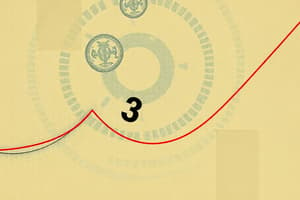Podcast
Questions and Answers
Which of the following factors would lead to a leftward shift in the aggregate demand (AD) curve?
Which of the following factors would lead to a leftward shift in the aggregate demand (AD) curve?
- A decrease in consumer confidence (correct)
- An increase in government spending
- A decrease in the price level
- A decrease in interest rates
The aggregate demand curve slopes downward because...
The aggregate demand curve slopes downward because...
- as prices rise, the cost of production decreases, leading to increased profitability for businesses.
- as prices rise, the purchasing power of consumers decreases, leading to decreased demand for goods and services. (correct)
- as prices rise, the purchasing power of consumers increases, leading to increased demand for goods and services.
- as prices rise, businesses are encouraged to produce more goods and services, leading to increased supply.
Which of these is a component of aggregate demand?
Which of these is a component of aggregate demand?
- Government spending (correct)
- Inflation
- Depreciation of capital goods
- Imports
What would be the likely effect of a significant increase in the value of the US dollar relative to other currencies?
What would be the likely effect of a significant increase in the value of the US dollar relative to other currencies?
What would be the primary effect of a decrease in the real interest rate on the aggregate demand curve?
What would be the primary effect of a decrease in the real interest rate on the aggregate demand curve?
Which of the following would NOT cause a shift in the aggregate demand curve?
Which of the following would NOT cause a shift in the aggregate demand curve?
Suppose the government implements a policy of increased taxes on businesses. What is the likely effect on the aggregate demand curve?
Suppose the government implements a policy of increased taxes on businesses. What is the likely effect on the aggregate demand curve?
Which of these would be considered a determinant of aggregate demand?
Which of these would be considered a determinant of aggregate demand?
Which of the following would shift AD to the left? (Select all that apply)
Which of the following would shift AD to the left? (Select all that apply)
If the domestic currency appreciates, how does it affect AD?
If the domestic currency appreciates, how does it affect AD?
How would a boom in a major trading partner country affect domestic AD?
How would a boom in a major trading partner country affect domestic AD?
If the central bank lowers interest rates, what is the likely impact on AD?
If the central bank lowers interest rates, what is the likely impact on AD?
If inflation in an economy falls significantly, how does it affect AD?
If inflation in an economy falls significantly, how does it affect AD?
Which of the following policies would most effectively decrease AD in an inflationary period?
Which of the following policies would most effectively decrease AD in an inflationary period?
If the government increases regulations on businesses, what will likely happen to AD?
If the government increases regulations on businesses, what will likely happen to AD?
If a country experiences a sharp increase in oil prices, how would this likely affect AD?
If a country experiences a sharp increase in oil prices, how would this likely affect AD?
If the government imposes a tariff on imported goods, what will likely happen to aggregate demand (AD)?
If the government imposes a tariff on imported goods, what will likely happen to aggregate demand (AD)?
If a major technological innovation leads to increased productivity, how would this likely affect AD?
If a major technological innovation leads to increased productivity, how would this likely affect AD?
Flashcards
Shift AD Left
Shift AD Left
Occurs when government cuts spending, reducing Aggregate Demand (AD).
Depreciation of Currency
Depreciation of Currency
Leads to increased net exports, shifting AD to the right.
Recession in Trading Partner
Recession in Trading Partner
Causes domestic AD to shift left due to decreased exports.
High Interest Rates and AD
High Interest Rates and AD
Signup and view all the flashcards
Inflation's Effect on AD
Inflation's Effect on AD
Signup and view all the flashcards
Increase AD in Recession
Increase AD in Recession
Signup and view all the flashcards
Subsidies for Businesses
Subsidies for Businesses
Signup and view all the flashcards
Net Exports (X - M)
Net Exports (X - M)
Signup and view all the flashcards
Economic Growth Expectations
Economic Growth Expectations
Signup and view all the flashcards
Aggregate Demand (AD)
Aggregate Demand (AD)
Signup and view all the flashcards
Components of AD
Components of AD
Signup and view all the flashcards
Downward Sloping AD Curve
Downward Sloping AD Curve
Signup and view all the flashcards
Movement along AD Curve
Movement along AD Curve
Signup and view all the flashcards
Shift in AD Curve
Shift in AD Curve
Signup and view all the flashcards
Rightward Shift in AD
Rightward Shift in AD
Signup and view all the flashcards
Business Confidence and Investment
Business Confidence and Investment
Signup and view all the flashcards
Factors NOT in AD
Factors NOT in AD
Signup and view all the flashcards
Study Notes
Aggregate Demand (AD) and the AD Curve
- Aggregate Demand (AD): Represents the total spending on domestic goods and services at different price levels in an economy. It does not include savings.
Components of AD
- Components: Consumption (C), Government Spending (G), Net Exports (X - M).
Shape of the AD Curve
- Downward Sloping: The AD curve slopes downward because a higher price level reduces purchasing power and net exports, leading to decreased consumption, investment, and overall demand.
Movements vs. Shifts in the AD Curve
- Movement Along the Curve: Caused only by changes in the price level.
- Shift of the Curve: Caused by changes in determinants of aggregate demand, such as consumer confidence, interest rates, or government spending.
Causes of AD Shifts – Consumption (C)
- Increase in AD: Lower income tax increases disposable income, boosting consumption.
- Decrease in AD: Increase in interest rates, fall in consumer confidence and decrease in wealth levels decrease consumption.
Causes of AD Shifts – Investment (I)
- Increase in AD: Increased business confidence increases investment
Causes of AD Shifts – Government Spending (G)
- Increase in AD: Government increases spending.
- Decrease in AD: Government cuts spending.
Causes of AD Shifts – Net Exports (X – M)
- Increase in AD: Domestic currency depreciation makes exports cheaper and increases net exports.
- Decrease in AD: Domestic currency appreciation makes exports more expensive and decreases net exports.
- Recession in Major Trading partner: Decreases demand for exports and shifts AD to the left.
Interest Rates and AD
- Increase in Interest Rates: Decreases AD, as borrowing becomes more expensive.
- Decrease in Interest Rates: Increases AD.
The Effect of Inflation on AD
- Increased Inflation: Decreases AD as purchasing power declines.
Higher-Order Thinking MCQs
- Recession and AD Increase: Lowering interest rates and increasing government spending stimulates consumption and investment to increase AD during a recession.
- Government Subsidies and AD: Government subsidies reduce business costs, increasing investment and shifting AD to the right.
Studying That Suits You
Use AI to generate personalized quizzes and flashcards to suit your learning preferences.




